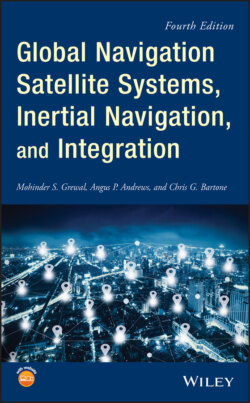Читать книгу Global Navigation Satellite Systems, Inertial Navigation, and Integration - Mohinder S. Grewal - Страница 21
1.2.1.2 Legacy GPS Signals
ОглавлениеEach GPS satellite carries a cesium and/or rubidium atomic clock (i.e. frequency reference oscillator) to provide timing information for the signals transmitted by the satellites. While each satellite carries several internal clock, all navigation signals are generated from one clock. Satellite clock corrections are provided to the users in the signals broadcast by each satellite, with the aid of the GPS Ground Control Segment. The legacy GPS satellite transmits two L‐band spread spectrum navigation signals on – an L1 signal with carrier frequency f1 = 1575.42 MHz and an L2 signal with carrier frequency f2 = 1227.6 MHz. These two frequencies are integral multiples f1 = 154f0 and f2 = 120f0 of a base frequency f0 = 10.23 MHz. The L1 signal from each satellite is binary phase‐shift keying (BPSK) modulated by two pseudorandom noise (PRN) codes in phase quadrature, designated as the C/A‐code and P(Y)‐code. The L2 signal from each satellite is BPSK modulated by only the P(Y)‐code. A brief description of the nature of these PRN codes follows, with greater detail given in Chapter 4.
Compensating for ionosphere propagation delays. The time delay from when a navigation signal is transmitted, to when the signal is received, is used to eventually estimate the distance between the satellite and the user. This signal propagation delay is affected by the atmosphere. As the signals pass through the ionosphere, the delay chances with frequency. This is one motivation for use of two different carrier signals, L1 and L2. Because delay through the ionosphere varies approximately as the inverse square of signal frequency f (delay ∝ f−2), the measurable differential delay between the two carrier frequencies can be used to compensate for the delay in each carrier (see Ref. [16] for details).
Code‐division multiplexing. Knowledge of the PRN codes allows users independent access to multiple GPS satellite signals on the same carrier frequency. The signal transmitted by a particular GPS signal can be selected by generating and matching, or correlating, the PRN code for that particular satellite. All PRN codes are known and are generated or stored in GPS satellite signal receivers. For legacy GPS there are two PRN codes transmitted from each satellite. The first PRN code from each GPS satellite, sometimes referred to as a precision code or P‐code, is a relatively long, fine‐grained code having an associated clock or chip rate of f0 = 10.23 MHz. A second PRN code from each GPS satellite, sometimes referred to as a clear or coarse acquisition code or C/A‐code, is intended to facilitate rapid satellite signal acquisition and handover to the P‐code. It is a relatively short, coarser‐grained code having an associated clock or chip rate of f0 = 1.023 MHz. The C/A‐code for any GPS satellite has a length of 1023 chips or time increments before it repeats. The full P‐code has a length of 259 days, during which each satellite transmits a unique portion of the full P‐code. The portion of P‐code used for a given GPS satellite has a length of precisely one week (seven days) before this code portion repeats. Accepted methods for generating the C/A‐code and P‐code were established by the satellite developer (Satellite Systems Division of Rockwell International Corporation) in 1991 [17].
Navigation signal. The GPS satellite bit stream includes navigational information on the ephemeris of the transmitting GPS satellite and an almanac for all GPS satellites, with parameters providing approximate corrections for ionospheric signal propagation delays suitable for single‐frequency receivers and for an offset time between satellite clock time and true GPS time. The legacy navigational information is transmitted at a rate of 50 baud. Further discussion of the GPS and techniques for obtaining position information from satellite signals can be found in chapter 4 of Ref. [18].
Precise positioning service (PPS). Formal, proprietary service PPS is the full‐accuracy, single‐receiver GPS positioning service provided to the United States and its allied military organizations and other selected agencies. This service includes access to the encrypted P(Y)‐code.
Standard positioning service (SPS). SPS provides GPS single‐receiver (stand‐alone) positioning service to any user on a continuous, worldwide basis. SPS is intended to provide access only to the C/A‐code and the L1 carrier.
